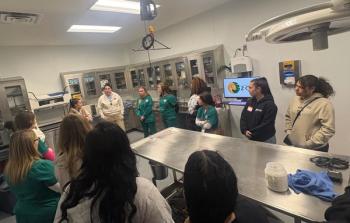
Open wide: Getting clients to "yes" with dental compliance
When it comes to informing clients about pets' oral health, it's as much how you and other veterinary team members say it as what you say.
Dentistry is all about great client communication. Without it, clients won't comply. And without compliance, the patient, the client, and your practice lose.
You probably deal with client non-compliance every day. Too bad our patients can't make treatment decisions for themselves. In the real world, we need the client to say yes to recommended therapy plans. When the client says no, it's all too easy to blame it on a lack of money or credit. But are we fooling ourselves into thinking that's the real reason?
Compliance seems to depend on what and, more important, how treatment recommendations are presented. Did you know that the words you speak to the client contribute to only 7 percent of that person's decision? How you say the words—and the body language and gestures you use—comprise 93 percent of your influence on the person's decision-making process. If you and your co-workers hope to influence a client's decision, you need to improve your overall presentation of treatment and management recommendations.
This is important stuff, because getting through to pet owners about the value of daily teeth brushing, regular oral exams, and dental cleanings—requiring the dreaded general anesthesia—can mean the difference in a patient's overall health and well-being. Easing client confusion, frustration, and genuine concerns regarding home care and dental procedures is the key to solidifying client trust and compliance. Here are some communication ideas that will help you improve your clients' understanding of dental health and get more of them on board with providing their pets with better dental care.
Show clients the evidence
Pictures and videos let clients see what exactly is going on inside their pet's mouth—and they're often surprised at what they see. This also gives clients a clearer picture of what's involved in the oral assessment, treatment, and prevention of dental disease. Technology makes it possible to take a picture in the exam room that's instantly enlarged on the computer screen. An Eye-Fi (Eye-Fi Inc.) card that you place in a digital camera, coupled with a wireless network, makes instant viewing available to all in the exam room.
Create to-go information
When the veterinarian has identified the oral pathology and you've taken a photo, you can then create a handout for the client that corresponds to the patient's condition. The handout may include information from a published article, veterinary textbook, or pamphlet from a source you trust. It should include pictures and be easy for the client to read and understand. This step adds credibility to your advice and gives clients a way to refer back to the information the team has provided during their visit.
Tell it like it is
The tone, pitch, and speed of your voice greatly influence a client's decision. Speak calmly, just like you would when talking to a friend. This helps clients see their pet's oral disease as you do—a real problem necessitating intervention. Emphasize the pain and discomfort associated with oral disease. In our practice, clients report to us daily on the difference dentistry has made in their pets' lives.
Remember that your gestures and facial expressions are powerful tools. They convey the magnitude of oral exam findings and the need for treatment. Clients need to know the significance of their pets' problems before they can attach a value to treatment. If during an oral exam, you and the veterinarian find advanced periodontal disease or discover a fractured tooth with pulp exposure, your facial expression is likely to give away the severity of the condition. Your clients' decisions are likely to be based on emotion, so don't downplay minor conditions and don't hold back on expressing the significance of advanced dental disease.
Eliminate distractions
Children, other pets, and cell phones are common exam-room distractions. Be aware of disruptions and have a plan for how to handle them—this is a must if you're going to gain compliance. To control distractions:
> Don't let the patient be the distraction. There are several ways to prevent pets from jumping or playing while the veterinarian explains the dental problem and treatment recommendations. Hold the pet so the client can concentrate on the matter at hand and focus on the doctor. Put smaller pets in their carriers while discussing the details. Separating the pet from the client is an effective way to hold the client's attention.
> Post a cell phone policy. Cell phones can be harder to control than bouncy pets, but a clearly posted cell phone policy in your waiting area and exam rooms may help. It's OK to remind clients that they can make or receive calls outside before entering the clinic.
> Use toys to control spirited kids. If you don't have the luxury of a kiddie corner in your practice, keep age-appropriate toys such as crayons or coloring books on hand. At the beginning of the exam, ask the child to draw a picture of the family and pets.
Overcome clients' objections
If finances are an issue, third-party payment plans can help, so be prepared to discuss this option with clients. We recommend pet insurance to clients from the moment we meet them until the moment they ask us to stop recommending it.
If the client's main concern is anesthesia complications, explain that choosing the proper protocol and monitoring for each patient allows the safest anesthesia possible. Put the need for treatment into perspective by relating the severe pain and progression of disease associated with leaving dental conditions untreated as compared to the small risk of complications associated with anesthesia.
Occasionally, clients don't want to deal with their pet's health issue at the time of a visit because of other events in their lives like a needed car repair, vacation, family issue, or a leaky roof. If this is the problem, offer to set up another appointment at a more convenient time to address the oral problem. This emphasizes your concern regarding the oral disease as well as your understanding of life's many complications.
Stop talking
During every oral assessment there comes a time when the veterinarian has explained everything and the client needs time to process the information. While the client is making a decision, the silence can be deafening. It may be hard to keep quiet at these times, and the urge to continue making the case can be irresistible. Try counting to 20 in your head to keep from interrupting the client's thoughts. This gives clients time to digest what the team has presented.
In the medical sense, compliance is a patient's adherence to a recommended course of treatment. By adhering to the communication tips above, compliance to your dental recommendations will improve, allowing you to provide your client and patient the best care possible—and that's what it's all about.
Paul Camilo, CVPM, is hospital administrator at All Pets Dental in Weston, Fla., and founder of Veterinary Consultation Services. To discuss this article, go to
Newsletter
From exam room tips to practice management insights, get trusted veterinary news delivered straight to your inbox—subscribe to dvm360.






